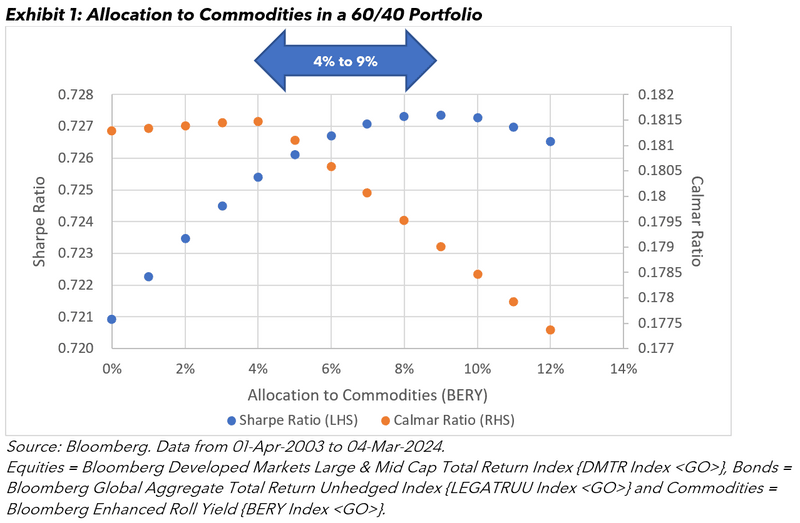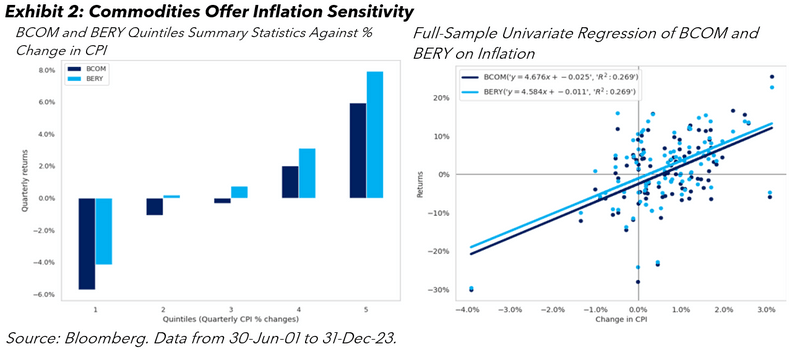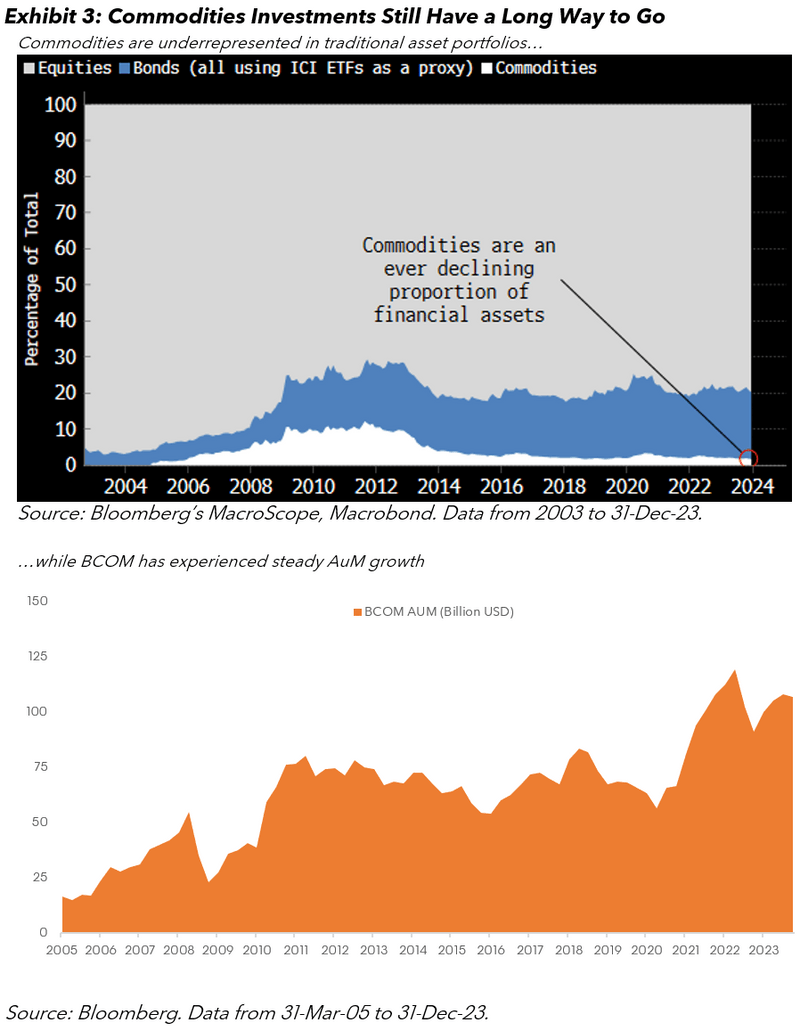This article was written by Jigna Gibb, Head of Commodities and Crypto Product Management at Bloomberg.
Commodities are high up on investors’ agendas again
As the asset class re-gains popularity, one of the first questions to be asked by allocators is how much to invest in commodities? The Bloomberg MacroScope article reported that as of January 2024 asset allocation to commodities stands at only 1.7% of total portfolios relative to equities and bonds. In this blog, we address whether the current allocations are optimal for meeting investment objectives, and how investors can determine the right investment sizing to commodities.
Explore our index families.
To begin with, we consider the primary reasons that commodities feature in a traditional global asset portfolio, which are for diversification benefits and inflation hedging purposes. With the current investment landscape, a traditional asset portfolio may not deliver returns as they did historically, hence adding commodities when tailwinds for equities and bonds are plentiful could lead to enhanced returns with lower volatility.
In a long-only commodities index the primary sources of performance are spot, roll and carry returns. The spot returns are market beta driven. Roll yield is harvested from the curve premium in futures contract selection. The carry premium is captured based on the shape of the commodities forward curve, i.e., assigning a greater weight to commodities in backwardation and lower weight to those in contango. Backwardation is when the forward curve is downwards sloping hence in an index there is a positive roll return and contango is an upward forward curve which can contribute negatively to index returns due to roll costs. The Bloomberg Commodities Index (BCOM) offers broad-based long-only benchmark exposure to commodities markets. Bloomberg Enhanced Roll Yield (BERY) index is a roll enhanced dynamically weighted strategy, which closely tracks BCOM, and can target spot, curve, and carry components of returns. Both BCOM and BERY are comprised of six sectors which are energy, grains, softs, industrial metals, precious metals, and livestock.
Commodities are a portfolio diversifier
In our analysis below, we plot the Sharpe ratios and Calmar ratios for the traditional 60/40 global equity/bond portfolio on the far left and then each of the portfolios by replacing an incremental 1% allocation to commodities as we move to the right.

By applying principles from modern portfolio theory, we can assess the Sharpe ratios versus Calmar ratios to determine an optimal allocation to commodities from a 60/40 portfolio. The Sharpe ratio is a measure of risk-adjusted returns calculated as the annualized return divided by volatility. The Calmar ratio is calculated as the annualized return divided by its maximum drawdown. Simply put, the Calmar ratio can be thought of how quickly the portfolio has recovered from the highest loss scenario based on historical annualized returns. For both Sharpe ratio and Calmar ratio, the higher the number, the more attractive the portfolio.
Based on these two metrics, we see that the ideal range for an allocation to commodities from the 60/40 portfolio is between 4% to 9%. The Calmar ratio improves up to 4% allocation and then begins to dip, however this decline is offset by the improvement in the Sharpe ratio up to a 9% to BERY from 60/40 portfolio.
For an effective inflation-hedge allocate to commodities
For inflation, we study the hedging characteristics of commodities against US CPI by testing the quintile-based data. The charts below highlight the stable relationship and attractive hedging characteristics of both BCOM and BERY against inflation. However, BERY offers greater inflation sensitivity compared to BCOM in the top quintiles and suffers less in the bottom quintile. This can fundamentally be explained that in periods of elevated inflation, physical markets remain in tight supply for prolonged periods of time which is when the carry premia from BERY can contribute additional returns.

The topic on how to appropriately size the commodities exposure to effectively hedge against inflation is discussed in the Cross Asset Investment Insight paper, “Hedging inflation risk in fixed income portfolio using commodities.” In the paper, Ghia et al. determine that there are two key considerations for assessing the commodities allocation which are 1) volatility of BERY compared to 60/40 portfolio and 2) maintaining the broad behavioral characteristics of the core portfolio. The long-term volatility of BERY has been 15.4% and over the equivalent sample period the volatility for the 60/40 portfolio has been 9.9%. We observed from the previous section that the addition of up to 9% allocation to commodities from a 60/40 portfolio does maintain similar properties of the core portfolio with respect to risk-adjusted return and drawdown profiles.
In terms of sizing the commodity exposure, Ghia et al. measure the inflation beta sensitivity of the asset and then allocate the inverse proportion for an effective inflation hedge. We conducted the same exercise of calculating the 3-year rolling beta of commodities, represented by BERY, against 10y US Breakevens since 2001 and get an average beta of 15. An inflation beta of 1 implies that a 1% increase inflation is accompanied by 1% increase in asset return. Based on this metric, the appropriate allocation to commodities as an inflation hedge comes to 6.7%, which is 1/15.

If commodities investments represent only 1.7% of total assets in portfolios, as detailed in the Bloomberg MacroScope article exemplified by ICI ETFs ownership, then commodities are deeply underrepresented in many asset portfolios.
Commodities have served to deliver portfolio diversification and inflation protection over multiple decades. During 2022, commodities gave positive returns while equities and bonds failed to perform, and Inflation remained elevated. The diversification-based analysis gave a target between 4% to 9% allocation to commodities from a traditional 60/40 portfolio. Our inflation-based studies indicate 6.7% commodities allocation to attain inflation-hedging characteristics.
In summary, we find that in terms of size of allocation a little goes a long way when it comes to allocating to commodities in a 60/40 portfolio, but there is a still a long way to go for asset allocation before meeting fair representation in traditional portfolios. BCOM and BERY are designed using liquid, replicable commodity futures contracts and designed to give exposure to broad commodities markets. Whether using it for diversification or inflation hedging purposes, both represent market standards to consider for a commodities allocation.
The data and other information included in this publication is for illustrative purposes only, available “as is”, non-binding and constitutes the provision of factual information, rather than financial product advice. BLOOMBERG and BLOOMBERG INDICES (the “Indices”) are trademarks or service marks of Bloomberg Finance L.P. (“BFLP”). BFLP and its affiliates, including BISL, the administrator of the Indices, or their licensors own all proprietary rights in the Indices. Bloomberg L.P. (“BLP”) or one of its subsidiaries provides BFLP, BISL and its subsidiaries with global marketing and operational support and service.




